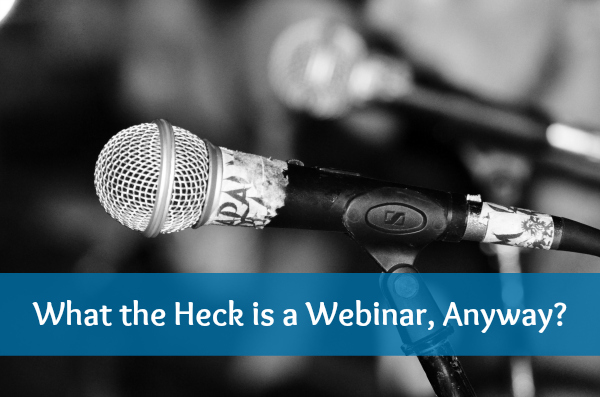 Every day, you probably receive another email, inviting you to attend a new webinar.
Every day, you probably receive another email, inviting you to attend a new webinar.
“Brand New Training!” the invitation says. “Learn new, valuable stuff from a trusted expert!”
It seems like absolutely everyone is hosting webinars these days.
Authors, speakers, coaches, therapists, social media experts, and other leaders are all using free and paid webinars to increase their online authority, connect with their audience members, and make money by selling products and services.
But what exactly is a webinar?
The word “webinar” originally came from “web seminar.” A webinar is essentially just a seminar or workshop held over the Internet, and it can be a presentation, discussion, demonstration, or other instructional session. Webinars can either be free or paid.
Webinars are sometimes called webcasts, online trainings, online events, seminars, or online classes.
You can use webinars in tons of different ways right now, but it’s helpful to learn some of the basics about webinars so you can decide if they might fit well into your business model.
So let’s take a look at some of the common traits of webinars. These statements aren’t hard and fast rules — there’s a big spectrum of what you can do with webinars — but most webinars have these things in common.
1. Most webinars include an audio component. Participants can listen to the presenter by using the speaker on their computers, or dialing in using regular land or cell phones.
2. Webinars typically include a visual component of some sort. Usually, the presenter shares his or her desktop with the audience, and shows participants a slide show or other document. But presenters can also show live examples from the web, or do a demonstration of a particular piece of software. I’ve done webinars were I’ve showed PowerPoint slides or PDF slides, but I’ve also showed a web browser to the audience and showed them live examples of blog posts, Pinterest, Facebook or another social media tool.
3. Most webinars are live events, in which the person who is presenting speaks directly to the audience. There are ways you can do pre-recorded or automatic webinars, but live events are more common.
4. The presenter uses a webinar tool to run the event over the Internet. Presenting a webinar to a live audience requires a special tool, and there are several software companies that specialize in webinar tools. GotoWebinar is one of the most well-known of these tools. Attendees view the event by using login information provided by the webinar service.
5. A lot of webinars include some interactivity between the presenter(s) and the audience members. Webinar services (like GotoWebinar) have special tools that allow the host to handle questions, run surveys or speak to participants one-on-one by unmuting their phone lives.
6. The goal of most webinars is to teach the attendees or answer questions, and there’s usually a loosely-planned structure of some sort. For example, one common structure for a free, promotional webinar might be:
- 5-10 minutes of introduction, including going over the agenda
- 60 minutes of how-to content (with presentation slides or a live demo)
- 15 minutes of Q&A
6. Webinars are either free (and often include some sort of pitch of a paid product or service) or paid (as part of a paid class or workshop). The flexibility of the platform makes webinars a great choice for all kinds of business purposes in many different industries and niches.
7. Webinar attendees can attend the event from anywhere (and any time zone) as long as they have an Internet connection.
What Makes Webinars Different From Other Events?
You may have heard other terms being used for online events, like the word “teleseminar” or “online summit.” Teleseminars are similar to webinars, but the presentation is audio only. The participants call in to a regular telephone conference line to hear the presentation, and there is no visual component delivered over the web.
Technically speaking, an event must have both audio and video components in order to be a webinar.
Why Do People Like Attending Webinars?
Webinar are appealing for lots of reasons. I like attending webinars because they’re interesting and educational at the same time. I almost always learn something when I’m attending a webinar, and because there are audio AND visual components, they’re super engaging.
I also feel like I can learn a lot about someone when they present a webinar. There’s something about hearing a person’s voice, listening to how they present, hearing their stories, that gives me a bit of insight into who that person is (and most importantly, whether or not I can trust them).
I’m not sure if I should admit this publicly or not, but I am an absolute sucker for a well-delivered webinar. If someone presents a good webinar, then offers me a relevant and reasonably-priced program or product, I’m probably going to dig out my wallet and buy it.
I will be the first to admit that I buy too many online products — and webinars are one of the reasons why!
Why You Should Consider Adding Webinars to Your Marketing (or Teaching) Mix
Webinars are an incredibly persuasive way to deliver a sales pitch, if you want to use them for sales, and a webinar is a great tool for delivering content when you’re teaching or coaching, too.
If you’re not currently using webinars as part of your online strategy, it’s worth your while to look into whether they might be a good fit for you, your audience and your business model.


4 thoughts on “What the Heck is a Webinar, Anyway?”
Generally, they are a time waster by people shilling something. People babble on; I can read much faster. Only if there is a pdf transcript are they possibly worthwhile. And they are usually scheduled at an inconvenient time.
I understand where you’re coming from, Maggie, and there are definitely folks who just waste your time and don’t actually have any useful information to share during the webinar. But there are a lot of people who really do share a lot of great, useful tips (for free) during webinars. If they do that, I don’t mind hearing a little sales pitch at the end of the event.
Perhaps they’re just not your cup of tea, though – they’re not a good fit for everyone!
Hi, Beth! Just read your post and so excited to hear more! My experience with webinars is completely different than Maggie Oster’s (above) so I wanted to take a minute to share my thoughts.
Yes, I’ve attended crappy trainings – both in person and online. But, when they are good . . . .They can be very, VERY good!
I especially love it when I get recordings, transcripts, podcasts, copies, of slides, links to additional resources, etc. In other words, when the presenter really has put thought and quality content into the material and then is generous enough to share those resources with me, I love them!
Although I always love that face-to-face interaction that comes with being in a room with a trainer, in some ways I end up getting more for my money with the webinars.
Like Maggie, I hate being pitched and sold to . . . but even that statement should be qualified because if you are giving me some screaming deal at the end of a great webinar . . . I don’t mind you trotting out your dog and pony show either!
Now that I write this, it occurs to me that maybe Maggie has been listening to folks who really don’t know what they’re doing . . . and really needing your training to get it right.
After all, if you’re doing it all wrong on a webinar, not only are you not going to be selling whatever it is that you’re selling . . . , you’re also probably going to be running people off – off the call, off the list, and at least in my profession, running them out of the office, too!
Maggie, I didn’t see a link to your website – Wondering what business are you in ?
Hey, Beth. I’m so glad you’re doing this! I’m with Tamara on the value of a good seminar of any type – live, phone, or web (and also the pain of a bad one).
I’ve been struggling with how to implement webinars into our business, especially in promoting a popular course we give 4x a year.
I’m not so much concerned about the reactions of people who disdain webinars or sales pitches after getting free training — you can’t please everyone.
What I want to know is how to reach more people like YOU who enjoy online learning and how webinars can be used to boost enrollments in a course.
How do you find/partner with blog/list owners to promote it? How far out from the course date do you host it? Do you take the Chris Brogan method and charge for a classroom style webinar with a large discount for the product pitch at the end?
These are all questions I have that I hope you’ll be addressing in the course. Looking forward to it!
Comments are closed.